Conosciamo la sensazione. Quel momento di sconforto in cui il vostro sito va giù e non avete idea del perché. È uno degli errori più comuni di WordPress, ma anche uno dei più misteriosi. Non vi dice cosa c’è che non va, ma solo che qualcosa è rotto.
La buona notizia? È quasi sempre risolvibile. Avendo aiutato innumerevoli personalizzati, abbiamo avuto a che fare con questo errore molto spesso.
In questa guida vi illustreremo i passaggi esatti per ripristinare il vostro sito e renderlo funzionante. Seguiteci e vedrete che tutto tornerà a funzionare in pochissimo tempo.
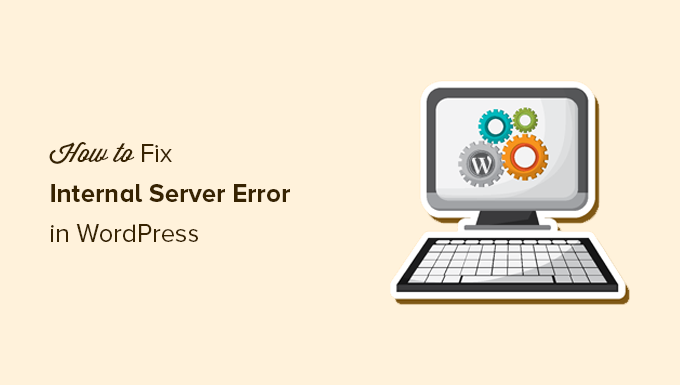
Ecco una rapida panoramica degli argomenti che tratteremo in questo articolo:
- What Is the 500 Internal Server Error?
- What Causes the Internal Server Error in WordPress?
- Fixing the 500 Internal Server Error in WordPress
- Clear WordPress and Browser Cache
- Checking for Corrupt .htaccess File
- Increasing the PHP Memory Limit
- Deactivate All WordPress Plugins
- Switch to a Default WordPress Theme
- Re-Uploading Core Files
- Enable Debug Logs in WordPress
- Ask Your Hosting Provider
- Video Tutorial
Che cos’è l’errore 500 Internal Server?
L’errore 500 Internal Server è come una porta bloccata senza chiave. Si sa che qualcosa non va, ma non c’è una nota che spieghi cosa è successo.
Questo errore non riguarda solo WordPress. Può apparire su qualsiasi sito web quando il server incontra un problema che non sa come gestire.
Il “500” nel messaggio è un codice di stato HTTP. Se lo cercate, troverete una definizione vaga:
“Il codice di risposta 500 Internal Server Error indica che il server ha incontrato una condizione inaspettata che gli ha impedito di soddisfare la richiesta”.
Non è molto utile, vero? È il modo in cui il server dice: “Si è rotto qualcosa, ma non sono sicuro di cosa”.
L’aspetto di questo errore dipende dalla configurazione dell’host e dal browser. Ecco un esempio di come appare su un server Apache:
Se il sito viene eseguito su Nginx, l’aspetto potrebbe essere leggermente diverso. Se Google Chrome non riesce a caricare una pagina di errore corretta, si vedrà qualcosa di simile:
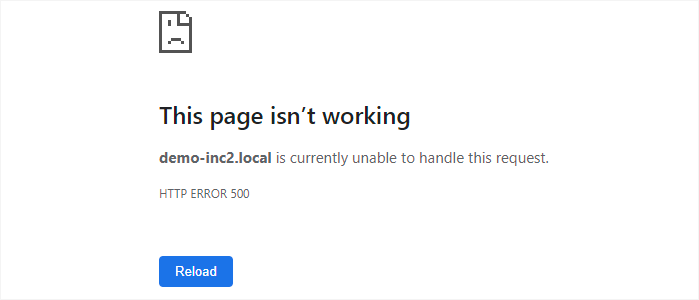
Per i principianti, questa situazione può risultare sconvolgente. Non c’è alcun messaggio che indichi cosa è andato storto o come correggerlo.
È come chiedere a un meccanico di correggere la vostra auto senza dirgli cosa è rotto. Dovranno controllare diverse parti fino a trovare il problema.
In base alla nostra esperienza, il modo migliore per correggere il problema è procedere passo dopo passo. Vi illustreremo le cause e le soluzioni più comuni per far sì che il vostro sito torni a funzionare.
Ottenete l’aiuto di un esperto in qualsiasi momento con il supporto WordPress on-demand!
Affrontare un errore interno del server può essere frustrante. Il nostro Supporto WordPress On-Demand è qui per aiutarvi a correggere i problemi tecnici in modo rapido ed efficace.
- Pagamento unico per l’assistenza on-demand di un esperto
- Tempi di consegna rapidi
- Disponibile 24 ore su 24, 7 giorni su 7
👉 O ttenete subito un supporto di emergenza per WordPress! 🛠️
Cosa causa l’errore interno del server in WordPress?
L’errore interno del server in WordPress è come un puzzle con pezzi mancanti. Sapete che qualcosa non va, ma il messaggio di errore non vi dice esattamente dove si trova il problema.
In base alla nostra esperienza, il colpevole più comune è un file .htaccess corrotto. A volte, si tratta di un plugin che si comporta male o di un tema che non funziona bene con la vostra configurazione.
Altre volte, il sito può colpire il limite di memoria PHP, causando il blocco di WordPress. Anche i file del core corrotti possono innescare questo errore, lasciandovi bloccati senza attenzione.
In alcuni casi, l’errore appare solo quando si cerca di accedere all’area di amministrazione di WordPress, mentre il resto del sito funziona correttamente. È come essere bloccati in casa propria mentre gli ospiti possono ancora entrare dalla porta sul retro.
Ciò che rende questo errore complicato è che di solito si verifica prima che WordPress possa essere caricato correttamente. Ciò significa che il server non può raccogliere abbastanza dettagli per spiegare cosa è andato storto.
Se volete dare un’occhiata più approfondita al funzionamento di WordPress dietro le quinte, consultate la nostra guida su come WordPress opera sotto il cofano.
Passiamo ora alla risoluzione dei problemi per ripristinare il funzionamento del sito.
Risolvere l’errore 500 Internal Server in WordPress
Prima di iniziare la risoluzione dei problemi, assicuratevi di avere a portata di mano un backup completo di WordPress del vostro sito web.
Se avete accesso all’area di amministrazione di WordPress, potete utilizzare un plugin di backup per WordPress per creare un backup completo del vostro sito web.
Per questo consigliamo di utilizzare Duplicator. Non solo vi aiuta a eseguire rapidamente il backup del vostro sito web, ma potete anche archiviare i vostri backup sul cloud e, soprattutto, potete ripristinare il vostro sito web dal backup.
D’altra parte, se non avete accesso all’area di amministrazione di WordPress, potete creare manualmente un backup di WordPress utilizzando phpMyAdmin e un client FTP.
In seguito, potete seguire i seguenti passaggi per risolvere il problema e risolvere l’errore del server interno sul vostro sito web.
Cancellare la cache di WordPress e del browser
I browser e i plugin di caching di WordPress possono talvolta memorizzare erroneamente una copia in cache di una pagina di errore.
Il modo più semplice per risolvere il problema è cancellare la cache del browser.
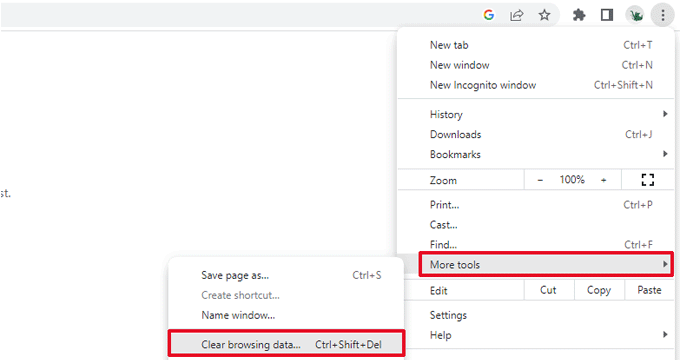
Dopodiché, se avete accesso all’area di amministrazione di WordPress del vostro sito web, potete svuotare la cache di WordPress visitando la pagina delle impostazioni del vostro plugin di caching.
Per maggiori dettagli, consultate il nostro tutorial su come cancellare la cache di WordPress.
Verifica della presenza di un file .htaccess corrotto
Il file .htaccess è un file di configurazione del server utilizzato da WordPress per impostare i reindirizzamenti.
Una delle cause più comuni di errore interno del server è il file .htaccess corrotto.
Il modo più semplice per correggere questo problema è semplicemente visitare la pagina Impostazioni ” Permalinks nell’area di amministrazione di WordPress e poi fare clic sul pulsante “Salva modifiche” senza apportare alcun cambiamento.
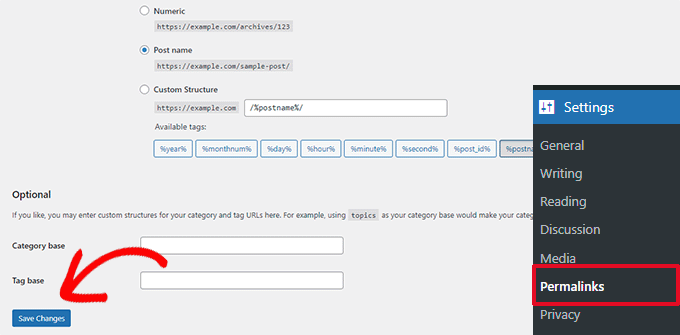
WordPress cercherà ora di aggiornare il file .htaccess o di generarne uno nuovo. Ora è possibile visitare il sito web per verificare se l’errore del server interno è stato corretto.
Se l’errore è ancora visibile, è necessario assicurarsi che WordPress sia stato in grado di generare o scrivere sul file .htaccess.
A volte, a causa delle autorizzazioni di file e directory, WordPress potrebbe non essere in grado di creare o scrivere sul file .htaccess.
Ora potete provare a sostituire il file .htaccess manualmente. Per prima cosa, dovete accedere al vostro sito web utilizzando l’FTP o l’applicazione File Manager nel pannello di controllo del vostro account di hosting.
Successivamente, è necessario rinominare ilfile .htaccess principale in qualcosa come .htaccess_old. Questo vi consente di mantenere il file come backup, ma WordPress non lo riconoscerà.
Per rinominare il file .htaccess, dovrete accedere al vostro sito utilizzando l’FTP o l’applicazione File Manager nel cruscotto del vostro account di hosting.
Una volta collegati, il file .htaccess si troverà nella stessa directory in cui sono presenti cartelle come wp-content, wp-admin e wp-includes.
È sufficiente fare clic con il tasto destro del mouse sul file .htaccess e rinominarlo in .htaccess_old.
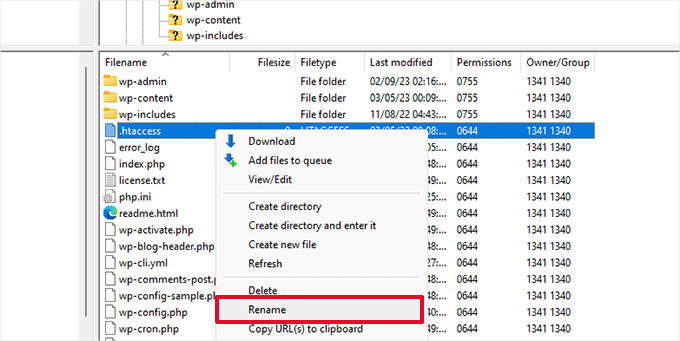
Successivamente, è necessario creare un nuovo file .htaccess.
All’interno della cartella principale del sito, fare clic con il tasto destro del mouse e selezionare l’opzione “Crea nuovo file” nel client FTP o nell’applicazione File Manager.
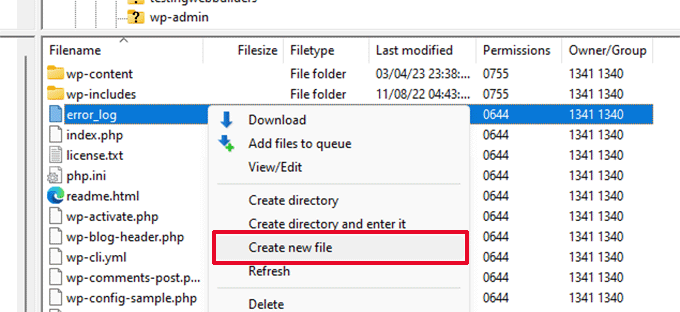
Nominate questo nuovo file .htaccess e fate clic su “OK” per salvarlo.
Ora, questo file .htaccess è attualmente vuoto ed è necessario aggiungervi le regole di riscrittura predefinite di WordPress.
È sufficiente fare clic con il tasto destro del mouse sul file e selezionare “Visualizza/Modifica” nel client FTP o nell’applicazione File Manager.
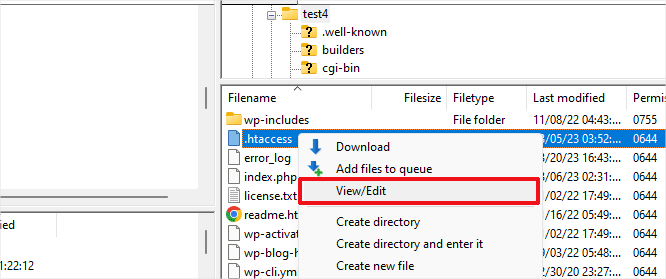
Il file vuoto si aprirà in un editor di testo semplice come Notepad o TextEdit.
A questo punto, è necessario copiare e incollare il seguente codice al suo interno:
1 2 3 4 5 6 7 8 9 10 | # BEGIN WordPress<IfModule mod_rewrite.c>RewriteEngine OnRewriteBase /RewriteRule ^index.php$ - [L]RewriteCond %{REQUEST_FILENAME} !-fRewriteCond %{REQUEST_FILENAME} !-dRewriteRule . /index.php [L]</IfModule># END WordPress |
Questo codice è il set di regole predefinito utilizzato da WordPress. Non dimenticate di salvare le modifiche e di caricare il file sul server.
Ora è possibile visitare il sito web per verificare se l’errore del server interno è stato risolto.
In caso affermativo, allora datevi una pacca sulla spalla perché avete risolto l’errore interno del server.
Importante: prima di procedere con altre operazioni, assicuratevi di andare alla pagina Impostazioni ” Permalinks nell ‘area di amministrazione di WordPress e di fare clic sul pulsante Salva senza apportare alcuna modifica. In questo modo il file .htaccess verrà rigenerato con regole di riscrittura adeguate per garantire che le pagine dei vostri post non restituiscano un errore 404.
Se la soluzione per verificare la presenza di un file .htaccess corrotto non ha funzionato, allora dovete continuare a leggere questo articolo.
Aumentare il limite di memoria di PHP
A volte, l’errore interno del server può verificarsi se uno script consuma tutto il limite di memoria di PHP.
Il modo più semplice per aumentare il limite di memoria di PHP è modificare il file wp-config.php. Se siete principianti, fate attenzione a questa operazione. Seguite attentamente queste istruzioni, perché anche piccoli errori nei file principali di WordPress possono danneggiare il vostro sito.
Per iniziare, è sufficiente collegarsi al proprio sito web WordPress utilizzando un client FTP o l’applicazione File Manager nel pannello di controllo del proprio account di hosting.
Il file wp-config.php si trova nella cartella principale del vostro sito web. Fate clic con il tasto destro del mouse su di esso e selezionate “Scarica”. In questo modo vi assicurerete di avere un file di backup nel caso in cui qualcosa vada storto.
Una volta salvato, è possibile fare clic con il pulsante destro del mouse e selezionare “Visualizza/Modifica”.
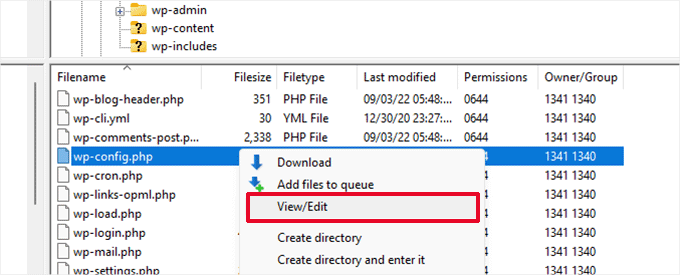
All’interno del file wp-config.php, è necessario aggiungere il seguente codice appena sopra la riga che recita: “Questo è tutto, smettete di modificare! Buona pubblicazione”:
1 | define( 'WP_MEMORY_LIMIT', '256M' ); |
Per maggiori dettagli, consultate il nostro tutorial su come aumentare il limite di memoria PHP in WordPress.
Nota: se 256M non risolve il problema, provare ad aumentare a 512M.
Se l’errore del server interno viene visualizzato solo quando si tenta di accedere all’amministrazione di WordPress o di caricare un’immagine in wp-admin, allora è necessario aumentare il limite di memoria seguendo questi passaggi:
- Creare un file di testo vuoto sul computer e chiamarlo php.ini.
- Incollare questo codice: memoria=256MB
- Salvare il file
- Caricate il file nella cartella /wp-admin/ tramite FTP.
Se l’aumento del limite di memoria ha risolto il problema, allora il problema è stato risolto solo temporaneamente. È ancora necessario trovare la causa che sta esaurendo il limite di memoria.
Potrebbe trattarsi di un plugin mal codificato o anche di una funzione del tema. Vi consigliamo vivamente di chiedere alla vostra società di web hosting WordPress di esaminare i log del server per aiutarvi a trovare la diagnostica esatta.
Se l’aumento del limite di memoria di PHP non ha corretto il problema, è necessario risolvere altri problemi.
Disattivare tutti i plugin di WordPress
Se nessuna delle soluzioni precedenti ha funzionato, è molto probabile che l’errore sia causato da un plugin specifico installato sul vostro sito web.
È anche possibile che si tratti di una combinazione di plugin che non funzionano bene tra loro.
Se potete accedere all’area di amministrazione di WordPress del vostro sito web, potete semplicemente andare alla pagina dei plugin e disattivare tutti i plugin di WordPress.
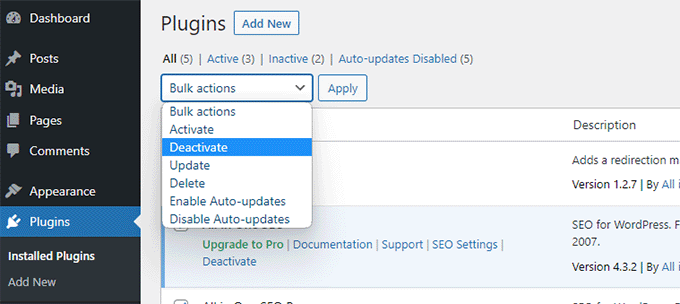
Tuttavia, se non riuscite ad accedere all’area di amministrazione di WordPress, potete disattivare tutti i plugin di WordPress utilizzando l’FTP.
È sufficiente collegarsi al proprio sito Web WordPress utilizzando un client FTP o l’applicazione di gestione dei file nel pannello di controllo del proprio account di hosting.
Una volta collegati, navigare nella cartella /wp-content/ e rinominare la cartella plugins in plugins.deactivated.
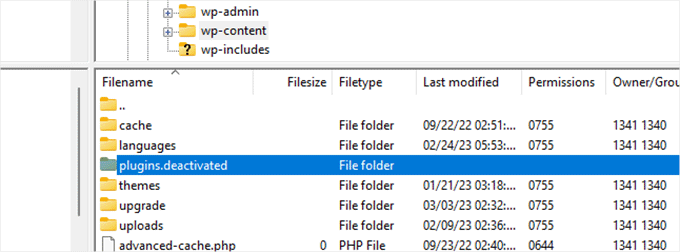
WordPress cerca i plugin nella cartella plugins. Se la cartella plugins non viene trovata, disattiverà automaticamente tutti i plugin.
Ora potete provare a visitare il vostro sito web per verificare se questo ha risolto l’errore del server interno sul vostro sito web.
Per ripristinare tutti i plugin, è sufficiente rinominare la cartella ‘plugins.deactivated’ in plugins.
I plugin verranno ripristinati, ma saranno ancora disattivati.
Ora è possibile attivare i singoli plugin e visitare il sito web per capire quale plugin sta causando l’errore interno del server.
Per maggiori dettagli, consultate la nostra guida su come disattivare tutti i plugin di WordPress senza wp-admin.
Se la disattivazione di tutti i plugin non ha risolto l’errore interno del server sul vostro sito web, continuate a leggere.
Passare a un tema WordPress predefinito
Una possibile causa dell’errore del server interno potrebbe essere un codice del tema di WordPress.
Per determinare se questo è il caso, è necessario cambiare il tema con un tema predefinito di WordPress.
Se avete accesso all’area di amministrazione di WordPress, andate alla pagina Aspetto ” Temi. Se è già installato un tema predefinito, è sufficiente fare clic sul pulsante Attiva per cambiare il tema.
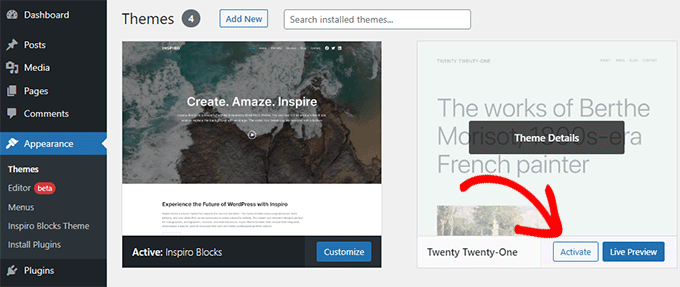
Se non avete installato un tema predefinito, potete fare clic sul pulsante “Aggiungi nuovo” in alto e installare un tema predefinito (Twenty Twenty-Three, Twenty Twenty-Two e così via).
Se non avete accesso all’area di amministrazione di WordPress, potete comunque passare a un tema predefinito.
È sufficiente collegarsi al proprio sito web WordPress utilizzando un client FTP e navigare nella cartella /wp-content/.
Fare clic con il pulsante destro del mouse per selezionare la cartella dei temi e scaricarla sul computer come backup.
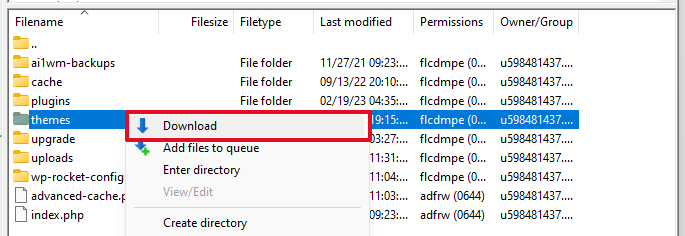
Successivamente, è necessario eliminare la cartella themes dal sito web. Una volta eliminata, creare una nuova cartella themes.
La nuova cartella dei temi sarà completamente vuota, il che significa che al momento non è stato installato alcun tema di WordPress.
Successivamente, è necessario visitare la directory dei temi di WordPress e scaricare un tema predefinito di WordPress sul computer.
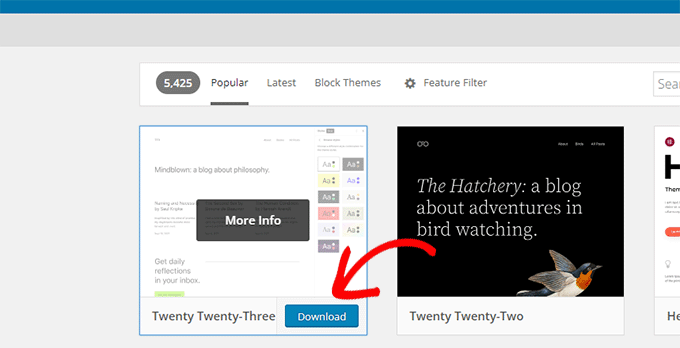
Il vostro browser scaricherà quindi il tema come file zip sul vostro computer.
Individuare il file sul computer e decomprimerlo. Gli utenti di Windows possono decomprimere il file facendo clic con il pulsante destro del mouse e selezionando “Estrai tutto”. Gli utenti Mac possono fare doppio clic sul file zip per estrarlo.
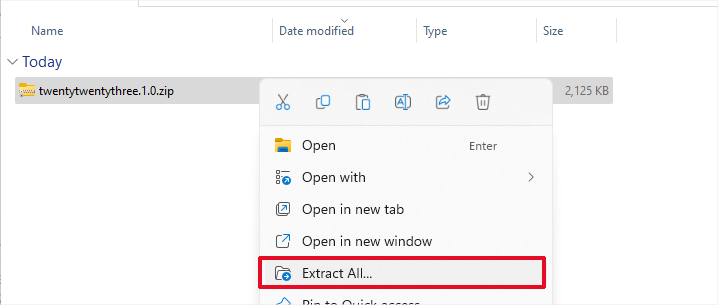
Ora vedrete una cartella contenente il vostro tema di WordPress.
Passare nuovamente al client FTP o al File Manager e caricare questa cartella nella cartella vuota dei temi.
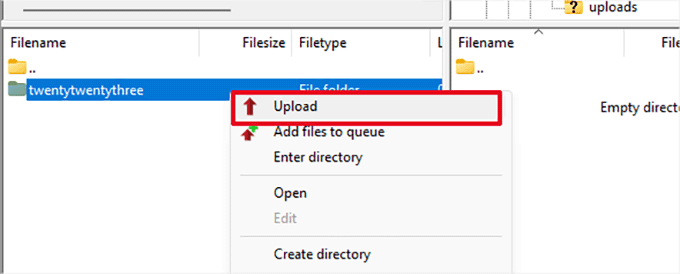
Una volta caricato, WordPress inizierà automaticamente a utilizzare il tema predefinito.
Ora è possibile visitare il sito web per verificare se l’errore del server interno è stato risolto.
Se non funziona, potete ricaricare i vostri temi WordPress dal backup o tornare al tema che stavate usando.
Non preoccupatevi. Ci sono ancora alcune cose che potete fare per risolvere l’errore.
Ricaricamento dei file del nucleo
Se le opzioni dei plugin e dei temi non hanno risolto l’errore interno del server, è opportuno ricaricare le cartelle /wp-admin/ e /wp-includes/ da una nuova installazione di WordPress.
Questa operazione NON rimuove le informazioni, ma può risolvere il problema nel caso in cui un file sia danneggiato.
Per prima cosa, è necessario visitare il sito web WordPress.org e fare clic sul pulsante “Download”.
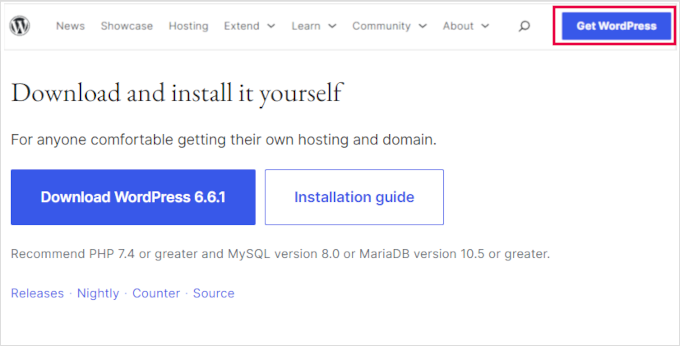
Questo scaricherà il file zip di WordPress sul vostro computer.
Procedere con l’estrazione del file zip. Al suo interno troverete una cartella wordpress.

Successivamente, è necessario collegarsi al proprio sito web WordPress utilizzando un client FTP.
Una volta collegati, accedere alla cartella principale del sito web. È la cartella che contiene le cartelle wp-admin, wp-includes e wp-content.
Nella colonna di sinistra, aprite la cartella WordPress sul vostro computer.
Ora è necessario selezionare tutti i file presenti nella cartella di wordpress e caricarli sul sito web.
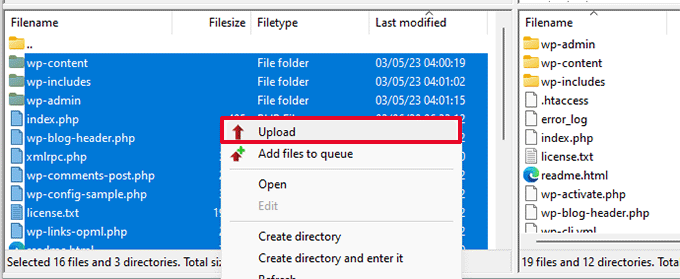
Il vostro client FTP trasferirà ora queste cartelle sul vostro server.
Verrà chiesto se si desidera sovrascrivere i file. Selezionare “Sovrascrivi”, quindi selezionare “Usa sempre questa azione” e selezionare la casella di controllo “Applica solo alla coda corrente”.
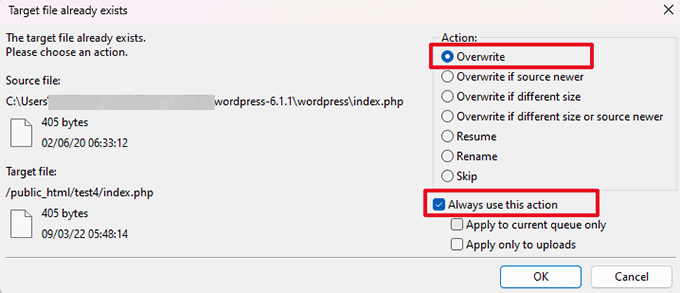
Il vostro client FTP sostituirà ora i vecchi file di WordPress con nuove copie fresche.
Se i file di WordPress sono stati danneggiati, questo passaggio risolverà l’errore interno del server.
Abilitare i log di debug in WordPress
WordPress è dotato di un sistema integrato per mantenere i log per il debug.
È possibile attivarlo utilizzando il plugin WP Debugging. Per maggiori dettagli, consultate la nostra guida su come installare un plugin di WordPress.
Una volta attivato, il plugin attiva i log di debug sul vostro sito web WordPress.
Se non avete accesso all’area di amministrazione del vostro sito WordPress, potete attivare il debug aggiungendo il seguente codice al file wp-config.php:
1 2 | define( 'WP_DEBUG', true);define( 'WP_DEBUG_LOG', true); |
Una volta attivati i log di debug, è possibile visualizzarli utilizzando un client FTP e navigando alla cartella /wp-content/.
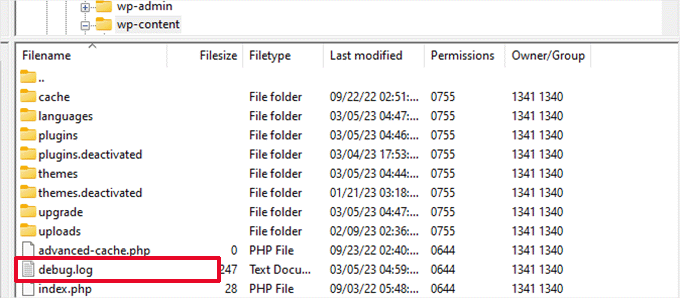
Il file di log di debug può essere aperto in un editor di testo e mostrerà un elenco di errori e avvisi che si verificano sul sito web.
Alcuni errori e avvisi possono essere incidenti innocui che non devono essere risolti. Tuttavia, se il vostro sito web presenta un errore interno del server, questi possono indicarvi la giusta direzione.
Chiedete al vostro fornitore di hosting
Se tutti i metodi non riescono a risolvere l’errore interno del server sul vostro sito web, allora è il momento di chiedere aiuto.
Contattare il team di assistenza del web hosting, che sarà in grado di controllare i registri del server e individuare la causa principale dell’errore.
Se volete continuare a risolvere i problemi da soli, consultate la nostra guida definitiva alla risoluzione dei problemi di WordPress per i principianti.
Video tutorial
Se questo articolo vi è piaciuto, iscrivetevi al nostro canale YouTube per le esercitazioni video su WordPress. Potete trovarci anche su Twitter e Facebook.





krzysiek
in my case it was simple although i spend few hours… I typed wrong sql server. Suprisingly it didn’t throw window with wrong config settings.
WPBeginner Staff
You can download the old .htaccess file to your computer as backup.
Ronaldo
Hi!
Thanks for this information. I renamed the .htaccess and my sites are up and running. My server is godaddy.
My question is, can I erase the old renamed .htaccess , because I called many times to godaddy to fix this kind of 500 internal error after many callings ?
Thanks
brooke
thank you! that just saved the day when I made the .htaccess ftp change. i can breathe again… ; D
itechaleart
i am facing this 500 error to last 15 days on godaddy hosting. i have tried everything what ever you mention here but not able to solve this error and also called godaddy for help, he said site are working fine on our site you check in different system.
Now feeling hopeless and thinking to move another hosting provider…
plz help me and suggest me for better option for hosting.
Thank you.
Silvia
Hello
i had the same problem with my website and went through all
your advices, without solving it. At the end i contacted my host and
they checked things for me, finding that some folders in the FTP had
CHMOD permissions different from 775. I didn’t do anything to cause
that, it just happened one day and i can’t get why. Anyway they fixed
the problem for me and said it’s easily manageable with ftp clients or
via their own file manager.
Just hoping it may be useful
pun
My prob is solve, thank you for this tutorial, thank you sooo much
Arun
Hi, I’m a non-techie and a newbie… Had this issue of Internal server error last week. It all began with my admin access getting restricted. But the site was working well. Sat through this with the Hosting provider (GoDaddy) for more than 4.5 hours through the night with 3 different personnel.(This was the 3rd time over a period of 4 days or so) They were helpful to a certain extent and identified the problem (wp-admin folder was missing). They emphasized that I should have deleted it as they did not have access(Just 2 days back they changed the files for me!!). I was logging in after a periodof 7 or 8 months of setting up the site. Anyways, I asked if they could restore the folder to a previous date. They denied. The solution given was a fee of $150, where they will “try” to find out the file changes etc, but with no guarentee. (While reading the above, I assume they should have used the above content as the questions/instructions were in the above written order).
Anyways, from one of the discussions (forgot the site), I found that if the wp-admin folder(of the version installed) is put in, it should solve. Yes, it did work for me… I activated all my plugins(they had deactivated it) and the site was working. I also updated all the plugins and themes that i was using/trying. the site is up and running!
deemyboy
@Levent Ultanur
One of the reason’s that some people might be getting an error with .htaccess and not with images is because they might be uploading it as a binary.
In Filezilla (at least) you can set the transfer type in the Transfer menu tab to:
auto
binary
ascii
I’m not certain but “auto” should usually work fine but it you’re only uploading text then maybe switch to “ascii” for that upload session, but remember to switch back again.
I never knew about this till yesterday when all the images on my site were being corrupted when I downloaded them to local. So I googled and found a post mentioning transfer type “binary” for images, but when I checked I found the transfer type was set to “ascii” (for text – I don’t know how as I don’t remember touching it!!) So I switched it to “binary” and my images came down perfectly as before.
The reason I say that “auto” is fine is because I’ve up and downloaded complete sites with a mixture of images (png, jpeg, gif etc) and text files (.php, .html, .css) and never had to set each transfer type individually or set it to “ascii” and upload only text files, then switch to binary and upload only images – Filezilla handles it all automatically…normally!
In fact I was totally unaware of this setting and I’ve been using Filezilla for around 2 or 3 years!
That MIGHT be the problem so get your clients to check the transfer type on their ftp application
I hope it helps!
deemyboy
You have not emphasised STRONGLY enough in the solution which replaces the WordPress core that people should
a) backup the wp-content folder <— this is your website (plus the wp database which doesn't come into this as it should be unnaffected by replacing the core)
b) make sure when they replace wp-admin and wp-includes they do not grab all 3 folders (ie. do NOT include wp-content) when uploading the new core
Henrique
Thank you very much!
Deepanshu Kakkar
Thanks
Basha
Very Very Useful Article…Thank..you so much
Guan
500 internal server error after activated wordpress plugins
Warix
Thank you so much, it was problem in plugins
Kristian Frisk
Thanks for this post. Learned (the bitter way) how much grief a bad plugin can cause to a wordpress site.
F. Parisis
Thank you very very very much! That was the best and only place where I found solution, after a day’s search on the web.
Tom Grant
Good job-massive help!
Anurag
A Big THUMBS up to this tutorial
Md.Zelal Hossain
Thank you so much for the nice tutorial..!!!!
Mulyadi Subali
you’ve just saved my day. thanks!
imam
Ok thanks
Levent Ultanur
Hey guys n girls…
What i dont get with this error is that i CAN upload images without getting the http error but My client gets the error… Same server, same files… Why ooo why… Anybody?
Kyle Hunzinger
Thank you it was the PHP Memory Limit!
Uwe
Thank you very much! The .htaccess was the reason!
Mark C.
Hi, guys. Awesome post! I use this page every time I get an Internal Server error.
I would offer an additional step, however. Actually, this should be the very first step before anything else is done. That is to verify there is not a problem with the web host.
I went through all the usual steps this morning on a client’s site that went down an hour ago only to find, quite by chance, that PHP was not working on the host. A quick check of the service bulletins on the web host’s website indicated a problem had occurred with that particular server. So, all we can do is wait until they fix it. (there are other tricks like changing the A record to a different server, but that’s only if the server issue is long term.)
That said, other parts of the server are still functioning so a quick and dirty index.html was created just so visitors see something nice instead of an error.
It’s also handy to create a “test.php” file that demonstrates if PHP is working or not, and then try to access that file every so often. When service is restored, delete or rename the index.html so that the index.php will load instead.
Here is my test.php code:
PHP Test
<?php echo ‘<p>Hello World</p>’; ?>
I sure hope this helps someone in a similar boat. All the best.
Bwana
Thanks for your help! My site only exhibited the “500 Internal Server Error” when I tried to see what plugins were installed. Naturally, I figured there was a misbehaving plugin. After several attempts to fix the problem by removing all of the plugins, I found your article. Your “memory=64MB” in a clean php.ini, placed in wp-admin, did the trick. Now at least I can work with the site to determine what is hording all the RAM. Nice article!
Jorge Santos Velasco
Thank you very much!! this was very helpfull!!
Lakshay Sharma
Many thanks for this post, resoled my issue.
Denise O'Reilly
I have been locked out of logging into WordPress for 2 weeks, as it tells me the security certificate is not verified. Can someone fix this so I can log in?
WPBeginner Staff
Sometimes server misconfiguration gets fixed and the error does not come back again. If it does then you should contact your web host.
Jos
I have seen this twice. Just reloading the page fixed it. But can something still be wrong?
Matthew Newton
Thanks a bunch guys, I suspected it was the .htaccess and this confirmed it
WPBeginner Staff
Check out our guide on how to deactivate plugins in WordPress when not able to access admin area.
Jessica
I can’t even log on to my admin panel at all to try to deactivate plug-ins etc… I talked with my hosting provider and they couldn’t find any problems. Any suggestions for what to do when you can’t even get to the admin panel?
Mitesh Raghwani
Thank you so much for your help. A simple fix for what seemed a massive problem.
Kailash Ghodke
I tried All Things which described above , but not worked for me
Is any other option like to install new wordpress on domain with all old posts ???
Your Help is needed please help to fix that issue..!
Lidia Lewis
Thanks for this article! My .htaccess file was corrupt and every time I kept renaming it, another duplicate kept appearing! The site kept returning 500 error messages. What I didn’t realise was that I had to save the permalinks setting in WordPress to update the file. Hope this fixes it for good! Thanks so much.
Mark Brandson
Thank you so very much. The .htaccess trick worked. You saved my life!
Astrid
Deactivating the plug ins worked for me after the latest WP upgrade (April/8/14). Although I think it was the WP Mobile detector that was conflicting with my W3 cache who was the culprit.
Thanks so much you are a life saver!
My hosting company told me that I should have had a back up (which I thought I did via a plug in) and that if I wanted to get a recovery and back up I’d have to pay $75.00 bucks. Really? I am so disappointed but super happy I found this article.
BTW, You are my go to guys when it comes to easy to understand, step by step issues with WP, plugins and the like. We need you around– Keep up the good work. Truly appreciate your efforts.
You guys ROCK!
Subscribed and following
sangeetha menon
Hi Syed,
I have deleted the infected files as I kept getting the 500 Internal server error. Now the host provider has asked me to upload the fresh files .. As I dont have any clue , I have asked the host providers to fix it..
If i have to do it , when uploading to the web root should I give overwrite the existing files ?
Should I do the htaccess file fix too ? Pls help…
luka
Just change the php verison to 5.4 or higher. It work for me:)
Meg
O.M.G. Nothing like waking up to a lost webpage. And yes, I did panic, but luckily found your post, took a deep breath and actually fixed everything with the first step: corrupt htaccess file. THANK YOU! I really do need to learn more about WordPress.
Kevin
Thanks for the help, I was searching for quite a bit until I found your solution. I took a look at my .htaccess file and saw that it was corrupt, so I renamed it and it did the trick. Cheers
sherly
With your help I just fixed my 500 internal server error. I’m a total newbie so this is very helpful!! Thanks!!
Derrick
Hi Editorial Staff,
Thank you very much!! The best 500 internal server error remedy post I’ve came across just when I needed it!!
Thank you very much!!
Nepal
Very helpful! Thank you so much…
I didn’t do anything by myself but I contacted my hosting provider..Lets see how long will they take to fix this issue.
Anita Hunt
Thanks so much for your help
Keely
Thanks wpbeginner – the .htaccess fix worked for me
Olsi
Deleting whole themes via File Manager and leaving only 1 theme worked for me